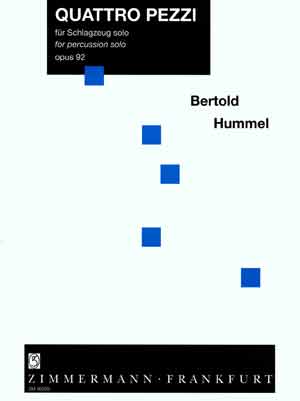Quattro Pezzi for percussion solo, op. 92 (1990)

I. Prologue
II. Allegro con brio
III.
A la Sarabande ![]() beginning
beginning
IV.
Vivace ![]() beginning
beginning
Instrumentation: Vibraphone, Snare drum, 2 Bongos, 2 Tom-Toms, Bass-drum, Tambour de basque, 2 Wood drums, 5 Log drums, 5 Templeblocks, 4 Suspended Cymbals , 1 Sizzle Cymbal, 1 Gong, 1 Tam-Tam, 2 Crotales, 1 Chinese Opera Gong (with up glissando), 1 Triangle, 2 Cow bells, 1 Vibraslap
First
performance : June 28, 1991 / Weilburg / Schlo▀
Peter Sadlo
Dedication: for Peter Sadlo
Duration: 18 Minutes
Publisher: Zimmermann Musikverlag Frankfurt ZM 30200 / ISMN: M-010-30200-3
The
Quattro Pezzi were composed for Peter Sadlo in 1990.
A whole variety
of percussion instruments is grouped around the solo instrument, the vibraphone.
In
the Prologue (I), mainly vibraphone and metal sounds determine the
various tonal characters and "invocative gestures".
The Allegro
con brio (II) provides a toccata-like framework for drum-head, wooden
and metal sounds and features 2 vibraphone solo passages; a melody reminiscent
of jazz music and backed by a "stubborn" ostinato figure attracts the listener's
particular attention.
A la Sarabande (III): A fantasy based
on a sarabande rhythm and consisting of several parts gives the player an opportunity
to fully explore the vibraphone 's tonal possibilities.
Vivace (IV):A
march episode forms the core of this virulent-virtuoso finale movement- sometimes
grotesquely alienated, sometimes containing a hymnic interpretation. After the
movement's beginning has been repeated in the form of a Variation, the coda briefly
quotes a sequence of notes from the prologue; finally, a stretta provides an effective
conclusion to the work.
Bertold Hummel
Press
Percussive Notes April 1996
The four
"pezzi" that comprise this tightly-written and well-planned work for
solo multi-percussionist explore the tonal possibilities of a large assortment
of instruments, while using the vibraphone as a focal point. In the "Prolog",
metallic timbres contributed by crotales, triangle, sizzle cymbal, gong and tam-tam
produce a rich amalgam of sound, especially when wedded to the sonority of the
vibraphone. The second movement introduces membranophones and wood timbres, with
the vibe contributing solo passages and an insistent ostinato pattern. The composer
describes the third movement, a vibe solo with subtle embellishments on metallic
percussion and vibraslap, as "a fantasy based on a sarabande rhythm."
The last movement, appropriately titled "Vivace" uses a multi-metric
scheme and rapid tempi, especially in the final section (Quarter note = 152),
ending the work on a virtuosic note. Hummel's style is eclectic, using everything
from chromaticism and passages relying on whole-tone patterns, to seventh chords
that impart a distinct jazz flavoring. The thirty-three individual instruments
that must be huddled in proximity to the vibraphone will require an ingenious
setup. However, the college percussionist who solves that challenge will reap
the benefits offered by this excellent work.
John R.Raush
